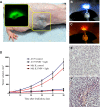Photodynamic therapy of melanoma by blue-light photoactivation of flavin mononucleotide
- PMID: 31273268
- PMCID: PMC6609768
- DOI: 10.1038/s41598-019-46115-w
Photodynamic therapy of melanoma by blue-light photoactivation of flavin mononucleotide
Abstract
Melanoma is one of the most aggressive and lethal form of cancer. Photodynamic therapy (PDT) is a clinically approved technique for cancer treatment, including non-melanoma skin cancer. However, the most of conventional photosensitizers are of low efficacy against melanoma due to the possible dark toxicity at high drug concentrations, melanin pigmentation, and induction of anti-oxidant defense mechanisms. In the current research we propose non-toxic flavin mononucleotide (FMN), which is a water-soluble form of riboflavin (vitamin B2) as a promising agent for photodynamic therapy of melanoma. We demonstrated selective accumulation of FMN in melanoma cells in vivo and in vitro in comparison with keratinocytes and fibroblasts. Blue light irradiation with dose 5 J/cm2 of melanoma cells pre-incubated with FMN led to cell death through apoptosis. Thus, the IC50 values of human melanoma A375, Mel IL, and Mel Z cells were in a range of FMN concentration 10-30 µM that can be achieved in tumor tissue under systemic administration. The efficiency of reactive oxygen species (ROS) generation under FMN blue light irradiation was measured in single melanoma cells by a label-free technique using an electrochemical nanoprobe in a real-time control manner. Melanoma xenograft regression in mice was observed as a result of intravenous injection of FMN followed by blue-light irradiation of tumor site. The inhibition of tumor growth was 85-90% within 50 days after PDT treatment.
Conflict of interest statement
The authors declare no competing interests.
Figures




References
Publication types
MeSH terms
Substances
LinkOut - more resources
Full Text Sources
Other Literature Sources
Medical

